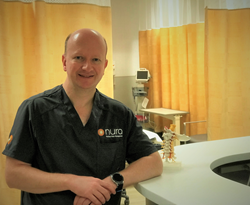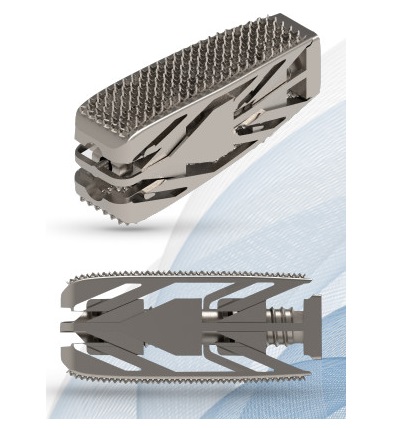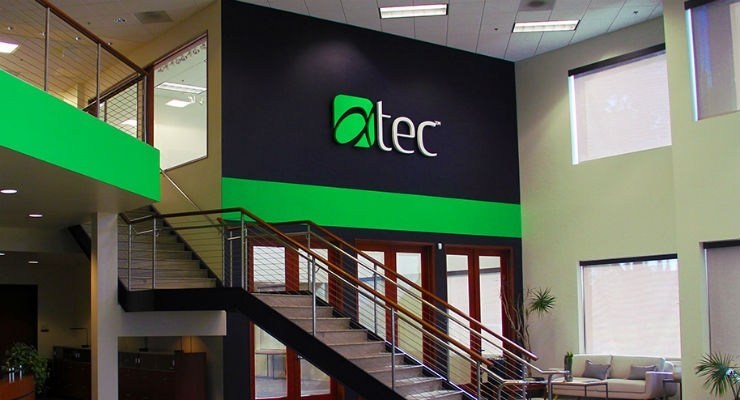Less Invasive Procedure Provides Virtually Immediate Relief With Less Patient Stress, Recovery Time and Cost than Traditional Surgery
MINNEAPOLIS (PRWEB) JUNE 10, 2021
In mid-January, Nura became the first clinic in Minnesota to perform an innovative new spinal fusion treatment that is less invasive, with faster recovery times and less expensive than traditional treatments that utilize rods and screws. The procedure is proving to be highly effective in helping people who experience debilitating pain due to spondylolisthesis and/or lumbar spinal stenosis – displaced vertebra that pinch or put pressure on nerves creating pain in the lower back and legs. While the degree of pain varies by patient, the condition can greatly impair mobility, the ability to perform simple or routine functions like walking and a person’s overall quality of life.
The new minimally invasive procedure performed by Nura’s Medical Director of Ambulatory Surgery Centers, Scott Stayner, MD, PhD, uses a small device called the Minuteman® Fusion Plate. It was developed by Harold Hess, MD, a board-certified Neurosurgeon, in Overland Park, Kan., and received FDA clearance in 2017.
The Minuteman device has dual functionality as a spacer and fusion for stabilization of grade 1 or grade 2 spondylolisthesis. The device is inserted through a one-inch-incision in the left flank. It is placed between the spinous processes at the narrowed level and props the canal open. The spacer is coated with hydroxyapatite that promotes bone growth into the device threads, which provides stabilization of mild to moderate spondylolisthesis. After coming out of anesthesia most patients notice an immediate improvement in pain levels and are usually able to resume daily activities within 24 hours.
“Patients report virtually immediate pain relief after undergoing the Minuteman procedure,” states Dr. Stayner. “They consistently tell us that walking is noticeably more comfortable within just 20 minutes of completing surgery. Leg pain tends to resolve completely after inserting the device. Many patients report being able to reduce their use of opioid and other pain medications after the procedure. We even had one patient schedule the removal of their spinal cord stimulator because their pain relief was so profound.”
Nura’s results are particularly remarkable because the clinic is one of the leading pain treatment specialists in the region. Its physicians frequently treat the most complex chronic pain conditions, with many of its patients having referrals from other doctors that have already exhausted all their options for alleviating a person’s suffering.
Typical spinal decompression and fusion surgery requires dissection of muscles and removal of bone to open the narrowed spinal canal. Rods and screws are often placed in the spine for stabilization. The surgery takes 2-3 hours, requires general anesthesia and a hospital stay of about three days, plus months of physical therapy.
The average cost of spinal fusion surgery in Minnesota is $36,433. Much of this cost is due to the increased length of surgery and the need for at least one overnight stay in the hospital. This does not reflect additional costs such as extensive physical therapy and rehabilitation, extended nursing care for elderly patients or time off work for younger patients.
The physical and financial demands of this traditional surgery are such that patients with other health conditions, such as uncontrolled diabetes, significant heart disease or advanced age are often left untreated over potential complications that could occur either during surgery or the recovery process. In addition, over time, areas of the spine surrounding the fused spinal level also tend to be affected – a phenomenon termed adjacent segment disease (ASD). Sometimes a second or even third surgery is required years after the initial surgery to treat recurrent symptoms due to degeneration of the adjoining levels.
Since January, Dr. Stayner has performed 28 Minuteman procedures. In comparison to traditional spine fusion surgery described above it offers several benefits. It can be performed as outpatient surgery in less than an hour via a small incision in the lower back. The patient goes home the same day and is usually able to resume activities of daily living within 24 hours. Additionally, the spine stabilizing muscles, bones and ligaments remain intact after the surgery. Even though the device promotes eventual fusion of the unstable level, it allows for micro movement at the adjacent levels which minimizes the risk of adjacent segment disease.
At roughly $20,000, the Minuteman procedure also costs less since it can be performed as outpatient surgery and does not require an overnight hospital stay. Plus, only minimal post-operative pain medication is needed after the procedure due to the small incision and shortened surgery time.
Elderly patients, especially those with symptomatic spinal stenosis, are often ideal candidates for the Minuteman fusion device since spine surgeons are hesitant to recommend open fusion due to increased risk of postoperative complications. Younger patients with mild to moderate lumbar spondylolisthesis can also benefit from the Minuteman procedure. Such patients often have fewer related issues. Therefore, treating lumbar spinal stenosis with this minimally invasive technique can result in even more dramatic improvements in function and pain.
Currently, the Minuteman device is covered for eligible patients through Medicare and most Medicare Advantage plans. Coverage for this treatment for non-Medicare plans is expanding as well.
About Nura
Nura (formally MAPS Medical Pain Clinics) was founded in 1995 by David Schultz, MD. Today, Nura’s multidisciplinary approach includes medication management, physical therapy and behavioral health coordinated with minimally invasive interventional procedures such as nerve blocks, spinal injections and nerve ablation. For more complex chronic pain problems, Nura offers a full range of implantable pain control options including spinal cord stimulation, dorsal root ganglion stimulation, peripheral nerve stimulation and targeted spinal drug delivery. Nura’s mission is to give chronic pain sufferers their lives back.
For more information about Nura’s pain management programs, visit: http://www.nuraclinics.com, or call 763-537-6000.








